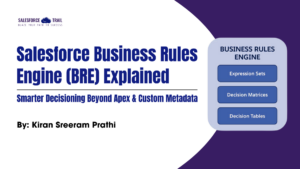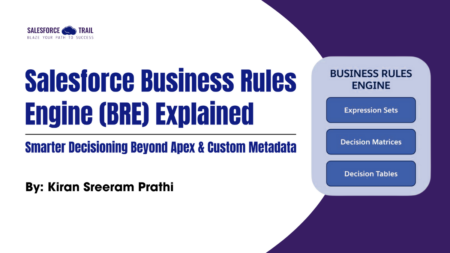Salesforce is the backbone of many businesses, helping them manage customer data, track interactions, and optimize processes. However, even the most advanced Salesforce implementation can become chaotic without proper data management. Poor data quality leads to inaccurate reporting, inefficient workflows, and compliance risks. Implementing Salesforce Data Management Best Practices is crucial for maintaining clean, secure, and actionable data.
In this blog, we’ll explore the top five best practices to ensure your Salesforce data remains reliable and valuable for your business operations.

Implement a Strong Data Governance Strategy
A well-defined data governance strategy is the foundation of effective Salesforce data management. It establishes clear guidelines for how data is entered within your organization. Key steps include:
- Defining data ownership roles and responsibilities.
- Establishing data quality metrics to track accuracy and completeness.
- Implementing training programs for users to follow best data entry practices.
- Creating a data governance committee to oversee compliance and updates.
By enforcing strong data governance, businesses can prevent inconsistencies and ensure that Salesforce remains a trusted source of information.
Regular Data Cleansing and Deduplication
Duplicate and outdated records can significantly degrade the quality of your Salesforce data, leading to inefficiencies and inaccurate reporting. Regular data cleansing and deduplication help maintain a streamlined database. Here’s how:
- Utilize Salesforce’s built-in deduplication tools like Duplicate Rules and Matching Rules.
- Schedule automated data cleaning processes to remove redundant records.
- Standardize data entry formats to minimize errors.
- Encourage users to follow best practices when inputting customer information.
Consistently maintaining clean data improves user productivity and enhances decision-making.
Enforce Data Validation Rules
To maintain high-quality data, Salesforce allows administrators to create validation rules that ensure only accurate and complete information is entered. Effective data validation involves:
- Setting mandatory fields to prevent incomplete data entry.
- Using formulas and expressions to validate formats (e.g., email and phone numbers).
- Implementing conditional logic to restrict incorrect data submission.
- Regularly reviewing and updating validation rules based on business needs.
By implementing validation rules correctly, businesses can reduce errors and maintain data integrity across departments.
Leverage Automation for Data Management
Salesforce provides powerful automation tools to simplify and enhance data management. By automating repetitive tasks, businesses can ensure consistency while reducing manual effort. The most effective automation techniques include:
- Using Workflow Rules and Process Builder to trigger automatic updates.
- Implementing Salesforce Flow to automate complex business processes.
- Setting up scheduled reports and alerts for data monitoring.
- Utilizing AI-powered tools like Einstein Analytics for predictive insights.
Automation ensures that data is consistently managed, reducing the risk of human error and improving overall efficiency.
Prioritize Data Security and Access Control
Data security is a critical aspect of Salesforce Data Management Best Practices. Protecting sensitive information helps businesses comply with industry regulations while preventing unauthorized access. Key security measures include:
- Enforcing Role-Based Access Control (RBAC) to limit data exposure.
- Configuring field-level security settings to protect confidential information.
- Enabling Salesforce Shield for enhanced encryption and compliance.
- Conducting regular security audits to identify potential vulnerabilities.
By enhancing data security, businesses can maintain customer trust and protect their valuable information from breaches.
Final Thoughts on Salesforce Data Management Best Practices
Effective Salesforce data management is not a one-time effort but an ongoing process. By implementing these five best practices—strong data governance, regular cleansing, data validation, automation, and security—businesses can maximize the value of their Salesforce investment.
A well-managed Salesforce system enhances operational efficiency, supports data-driven decision-making, and provides a seamless experience for users. Start implementing these best practices today to keep your data clean, secure, and actionable.
Are you looking for more ways to optimize your Salesforce environment? Stay updated with the latest insights and trends in Salesforce data management by following our blog!
Must Visit Links:
- The Role of AI Agents in 2025 in Shaping Salesforce Customer Service
- From Newbie to Salesforce Admin Certified: Ultimate Guide to Becoming One
- Salesforce MVP Nominations 2025 and becoming a Salesforce MVP Complete Guide
- Salesforce Developer Roadmap 2025: Your Complete Guide to Success
- 10 Proven Steps of Seamlessly Implementing Salesforce AgentForce
Resources
- [Salesforce Developer]- (https://developer.salesforce.com/)
- [Salesforce Success Community] (https://success.salesforce.com/)
For more insights, trends, and news related to Salesforce, stay tuned with Salesforce Trail

Mayank Sahu
I’m a Salesforce enthusiast passionate about CRM solutions, automation, and integrations. As a continuous learner, I stay updated with the latest Salesforce trends, tools, and innovations to share valuable insights and best practices. My goal is to help businesses and professionals maximize their Salesforce potential through actionable tips, industry updates, and strategic guidance.
Follow me for expert insights and the latest updates from the Salesforce ecosystem!
- Mayank Sahu#molongui-disabled-linkDecember 11, 2025
- Mayank Sahu#molongui-disabled-link
- Mayank Sahu#molongui-disabled-linkOctober 24, 2025
- Mayank Sahu#molongui-disabled-linkOctober 15, 2025



















